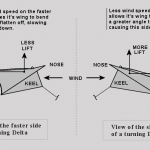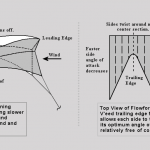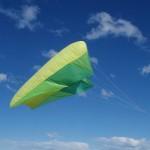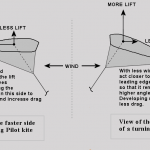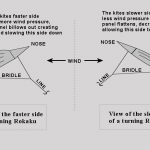RE-INVENTING THE WHEEL
The ‘something more dramatic’ that was to have been my subject this month is delayed on account of unsuitable weather- that is, it’s been kite flying as usual.
But my ear to the ground tells me that no-one is breathing down our necks or looking over our shoulders on this one (would this be called a double mixed metaphor?).
So, no time pressure (for a change), and the unaccustomed luxury (matching the accommodation here in Kuwait) of being able to wait until conditions do suit.
And, I ran out of page space last month and have been rather chaffing to tell the second part of that story, so read on for some more boring “why kites don’t fly stuff” stuff instead.
Every person who has ever made a kite, probably everyone who’s ever flown a kite, maybe even everyone who’s ever watched kites fly, is familiar with hunting and looping instability. This is when a kite starts to hunt from side to side with ever increasing amplitude as wind speed increases, eventually crashing out in a series of violent loops.
This sequence is set off if a kite, when correcting after getting a bit out of line, goes too far the opposite way, then in correcting from this over-correction, over-corrects even further the other way, and so on.
Whether corrections build or fade can depend on unimaginably small effects- which is why kite making is so rewarding and annoying:
*Rewarding when they fly well: Irrefutable proof of our cleverness.
*Annoying when they misbehave: Persecution by malign external influences.
*But in reality: We’re usually just being fooled by randomness.
Very occasionally it’s possible to identify some small difference that has a big effect on kite behaviour.
An early prototype of the 10sq.m 4 bridle Pilot design I described last month was stable in all winds while the next one was irretrievably unstable. Between these two kites, I had made a new template for the outer ribs (profiles) as the original was a bit wobbly- but when smoothing out the bumps, had inadvertently moved the widest point forward by just 80mm (each rib is 3.25m long). The actual change in the rib depth at any point is not more than 10mm or so, an amount that gets lost in fabric stretch when a cut rib is laid back on it’s template- but the first kite flew and the second didn’t- and with this change reversed, the next one flew just as well as the original.
Having lots of lateral area (keels, flares, vertical surfaces etc) is effective in preventing hunting/looping, but a 5,000 or 10,000 year older solution (from the first kite I expect) is to add a tail.
All kites are pendulums; their weight (acting at the kite’s centre of gravity) hanging beneath wind generated lift forces, points them upwards. When they tilt over to one side or the other because of unsteady winds, this pendulum effects corrects the lean and gets them back to pointing straight upwards again.
Tails enhance this pendulum effect because their weight , acting at the tail attachment point, has much more leverage. The tail’s aerodynamic drag also helps keep everything pointing upwind and works to damp out any hunting that threatens to take hold.
Tails have a ‘dynamic’ effect, in the sense that their corrective effect increases rapidly when a kite starts to behave badly- which is pretty much the opposite of how the “Department of Corrections” (prisons) function in New Zealand-, but I digress.
And there are other dynamic stabilising mechanisms that kites use.
Rokakus have one that I admire a lot. When a Rokaku begins to turn to one side or the other, aerodynamic forces and the kite’s structure combine to cause the camber of it’s centre section on the faster side to increase and that of the slower side to flatten- which resists the turning tendency and shuts down any hunting/looping build-up before it can establish.
Deltas (and Genki’s, and fighters when their bows aren’t too stiff) have another:
Their wingtip angle of attack decreases as wind speed increases: reducing lift (which is the driving force behind instability) and increasing drag (which has a stabilising effect). This is very clever; not only do they automatically de-power to maintain stability as wind speed increases (because lift decreases and drag increases as the wingtips flatten off in response to more wind pressure), but if one wing should happen to fly faster than the other, then it’s extra flattening-off response acts to slow that side, restore the kite to straight flying and damp out hunting before it can establish it’s baleful grip.
And there’s a dynamic stabilising effects that some ram air inflated kites use also.
The 4 bridle Pilot’s automatic de-power system described in last month’s newsletter (which works by lifting the kite’s trailing edge as wind speed increases to decrease angle of attack, reduce lift and increase drag) also has a dynamic stabilising effect. This is because, analogous to the delta kite dynamic stabilising system, when one side finds itself flying faster than the other, that side de-powers preferentially, and this immediately damps out any hunting behaviour that might have had a mind to get in on the act. Embarrassingly, I’ve been using this system for years without realising that I have been; my standard pilot designs have always (or at least from when I first ditched the central flare) used profiles that are cambered in their rear half (induced by the flares so that if the kite overflies it reverts to reflexive form to resist luffing) and this has been providing, I now see, at least some auto-depower and dynamic stability.
I didn’t understand why or how this worked until a few months ago, just knew that this camber somehow made these kites fly better.
And here’s where credit is really due: Flowforms have had this dynamic stabilising feature for at least 25 years, and even cleverer, they enhance it by having a giant vee in their centre trailing edge so that one side can twist freely relative to the other. My hat goes off to whoever first figured this- it’s an idea that’s right up there with clever dick Deltas and Rokakus.
Aagh!: Seems like I just invented the wheel, then find out I’m years too late and that my version isn’t even properly round!
Peter Lynn, Kuwait City, Feb 28, 2011
PS But the 4 bridle Pilots did get lucky in two other respects.
Moving their centre front bridle to the top skin- which was done to improve initial inflation and reduce collapsing- has provided two additional useful features:
This centre top bridle point can be used to attach another kite; these Pilots are completely stackable (and much more reliable when stacked than the centre cell slot system that is available with some 8 bridle models).
And, this top bridle point provides an excellent de-powering system. Pulling on this bridle (when it can be reached) de-powers the kite and makes even the 22sq.m versions easily handle-able in strong winds. I expect that a second line rigged from this bridle to the ground will become an effective safety system when using Pilot kites for lifting things (banners, trains etc) and will save a lot of heavy work when pulling stuff down if the wind doesn’t co-operate by dropping off at the day’s end (everywhere except Italy).


